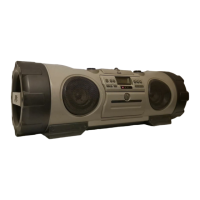What to do if a portion of CD does not play correctly on JVC Stereo System?
- MmarcusgutierrezSep 12, 2025
If a portion of a CD isn't playing correctly on your JVC Stereo System, check the CD for scratches and inspect the lens for any condensation.


What to do if a portion of CD does not play correctly on JVC Stereo System?
If a portion of a CD isn't playing correctly on your JVC Stereo System, check the CD for scratches and inspect the lens for any condensation.
Why doesn't the timer operation start on my JVC RV-B90 Stereo System?
The timer operation on your JVC Stereo System may not start if the current time is not set correctly or if the timer mode indicator is not displayed.
How to reduce noise during reception on a JVC RV-B90 Stereo System?
Try adjusting the antenna of your JVC Stereo System. Also, check if there is a TV set or computer device near the unit, as this could be causing interference.
Why won't the CD player play on my JVC Stereo System?
Check if the CD is upside down or dirty. Condensation on the lens may also prevent the CD player from working.
What causes a CD to skip or not play correctly on a JVC RV-B90 Stereo System?
A CD may skip or not play correctly on your JVC Stereo System if it is scratched or if there is condensation on the lens.
What to do when the JVC Stereo System operation stops?
If the operation of your JVC Stereo System stops, switch it to STANDBY and then back to ON.
Why the ONE TOUCH REC button does not function on JVC Stereo System?
If the ONE TOUCH REC button on your JVC Stereo System isn't working, check if the safety tabs of the cassette have been broken off.
What to do when JVC Stereo System operation stops?
If the operation of your JVC Stereo System stops, try switching the system to STANDBY and then back to ON.
Why is the clock time blinking on my JVC Stereo System?
If the clock time is blinking on your JVC Stereo System display, it might be due to a power failure or the power cord being unplugged while the memory back-up batteries were not installed.
How to fix JVC Stereo System if power cannot be turned on?
If your JVC Stereo System isn't powering on, the first thing you should check is whether the power cord is properly plugged in.
| Brand | JVC |
|---|---|
| Model | RV-B90 |
| Category | Stereo System |
| Language | English |
Safety precautions for Class 1 laser products, emphasizing avoiding direct beam exposure.
Details about the product's identification and certification labels.
Detailed instructions to prevent electric shocks, fire hazards, and damage to the unit.
Guidelines for safely handling the power cord, including avoiding wet hands and proper unplugging.
Precautions regarding internal access, metallic objects, ventilation holes, and lightning.
Ensuring adequate spacing around the unit for heat dissipation and proper operation.
Steps to take when the unit exhibits abnormal operation, involving power and battery reset.
Guidance on avoiding installation in places with vibrations, humidity, or magnetic interference.
Advice on closing the CD door to prevent dust on the lens and general lens care.
Managing condensation issues and avoiding extreme temperatures for unit longevity.
Proper volume adjustment for CDs and understanding the safety interlock mechanism.
Keeping tapes away from speakers due to magnets and avoiding TV picture distortion.
Cabinet cleaning, safe headphone listening, and general handling advice.
Instructions for safely using the unit's carrying handles to prevent damage.
Step-by-step guide for attaching and detaching the shoulder strap.
Information on where the remote control unit can be stored.
How to connect external audio units, turntables, or MD players using the AUX IN jack.
Connecting the AC power cord, including voltage selector usage and plug adapter.
Warning about potential TV picture distortion when the unit is placed near a television.
Installing AA batteries to maintain memory backup during power failures.
Notes on AA battery power, consumption, replacement, and using D-size batteries.
Identifying symptoms of low batteries and general cautions for correct battery usage.
Safety measures regarding battery chemical leakage, skin contact, and cleaning.
Using the specified car adapter, vehicle safety, and engine operation during car battery use.
Proper transport methods and protecting the unit from water and dust when left in a car.
Identification and function of the main controls and indicators for the CD player section.
Identification and function of the controls for the tuner and cassette deck sections.
Details of the rear panel connections, including DC IN, headphone jack, and antenna.
Instructions for installing batteries and replacing them in the remote control unit.
Tips for effective remote control operation, including range, lighting, and obstacles.
Explanation of the functions of each button on the remote control unit.
How to switch the unit's power on and off, including standby mode.
Using the COMPU PLAY function for one-touch source selection and playback.
Adjusting the main volume level using the unit's knob or remote control.
Adjusting the super woofer volume to enhance bass sound reproduction.
Using the ACS button to improve sound quality by emphasizing high frequencies.
How to select different sound modes (BEAT, POP, CLEAR, FLAT) to enhance music playback.
Explanation of each sound mode's purpose and when to use it for different music genres.
Guidelines for using compatible CDs and proper handling to prevent damage.
Proper storage methods for CDs and instructions on cleaning CDs with a soft cloth.
Note regarding the incompatibility of specially shaped CDs like heart or flower shapes.
Step-by-step guide to playing an entire CD, including loading and volume adjustment.
How to stop CD playback mid-play or temporarily pause it.
Information on error indications that may appear due to CD condition or loading.
Avoiding damage by using the unit within specified temperature ranges and preventing shocks.
Using skip play to move between tracks and search play for locating specific positions on a CD.
Playing specific tracks directly using track number buttons on the remote control.
How to program up to 20 tracks for playback in a desired order.
Selecting modes for repeating a single track or all tracks on a CD.
Activating random playback for playing tracks in a shuffled order.
How to view programmed track details and clear the program.
Detailed explanation of repeat and random playback functions with the remote.
Notes on programmed playback, including time limits and potential playback issues.
Proper handling of cassette tapes, including tightening loose tape and precautions against accidental erasure.
Steps for loading cassette tapes and how the auto tape select mechanism distinguishes tape types.
Important notes regarding tape playback and the auto tape select mechanism.
Step-by-step guide for playing a cassette tape, including loading and volume adjustment.
Understanding different tape reverse modes and how the tape stops automatically.
Instructions for fast-forwarding and rewinding cassette tapes.
How to connect and use external audio sources like turntables or MD players via the AUX IN jack.
General steps for tuning into radio broadcasts using the TUNER BAND button.
Selecting FM stereo or mono reception for optimal sound quality based on broadcast signal.
Using seek tuning for automatic station finding and manual tuning for precise frequency selection.
Automatically scanning and storing the first 15 radio stations found in memory.
Manually programming desired radio stations into memory using preset buttons.
How to select and listen to previously preset radio stations.
Information on how preset stations are stored and notes on potential data loss.
Ensuring preset station data is retained during power interruptions using back-up batteries.
Optimizing reception by adjusting telescopic and ferrite core antennas.
Warning about potential interference to AM/SW reception from nearby televisions.
Adjusting channel intervals for AM and FM frequencies, especially for North/South America.
Explanation of the ALC circuit and checks for cassette safety tabs.
Step-by-step guide for synchronized recording from a CD to a cassette tape.
Setting up for synchronized recording, including source selection and handling of non-recorded sections.
Handling recording direction changes and interrupting recording.
Using the synchro recording mode for full CD recording, including reverse side recording.
Techniques for recording without non-recorded gaps between tracks or tunes.
Steps for rewinding a cassette tape using the TAPE and REW buttons.
How to record broadcasts from the radio or audio from external sources connected to AUX IN.
Using the BEAT CUT button to eliminate beats during AM broadcast recording.
Methods for erasing recorded material from a tape to record new content.
Connecting and operating the microphone for mixing with other audio sources and recording.
Identification and functions of the controls on the remote for clock and timer adjustments.
Step-by-step guide to setting the current time on the unit using the remote control.
Methods for confirming the set time and adjusting to the nearest second using TV/radio signals.
Essential prerequisites for timer operations, including setting the current time and battery status.
Procedure for setting the desired start and stop times for timer recording or playback.
How to select the desired source mode (TUNER, CD, TAPE) for timer operations.
Adjusting the volume level for timer playback and understanding 'VOL -' setting.
Steps to confirm that the timer settings have been completed correctly.
Steps to set up timer recording for radio broadcasts, including tuning and standby mode.
How timer recording starts, stops, and can be repeated daily.
Procedure to cancel timer recording or playback operations.
Overview of timer playback capabilities for tapes, broadcasts, and CDs.
Steps to set the timer, select the source, and put the unit in standby for timer playback.
Details on how timer playback starts, indicators, fade-in, and how to cancel the operation.
Using the sleep timer to automatically turn off the unit after a set time while listening to audio.
Setting sleep times, verifying remaining time, and canceling the sleep timer operation.
Using sleep timer for listening and setting up timer playback for the next morning.
Explanation of why regular cleaning of heads, capstan, and pinch roller is crucial for sound quality.
Detailed steps for cleaning tape path components and recommendations for cleaning kits.
Precautions to avoid head magnetization and using appropriate cleaning agents like alcohol.
Instructions for cleaning the CD player lens using a blower or cotton swab to ensure proper playback.
Solutions for common problems like the unit not turning on or having no sound output.
Troubleshooting steps for CD player issues such as discs not playing, partial playback, or operation stopping.
Resolving issues with cassette playback volume, ONE TOUCH REC, and noisy radio reception.
Diagnosing and fixing problems with timer operations and the remote control unit.
Technical specifications for the CD player, including frequency response and signal-to-noise ratio.
Technical details for the tape deck, speakers, power output, and input/output terminals.
Details on required power sources, voltage compatibility, and power consumption figures.
List of items included in the product package, such as remote control and batteries.
Explanation of area suffixes used to denote regional versions of the product.